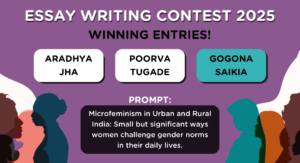– Aradhya Jha
In some parts of rural Maharashtra, daughters, sisters, wives, and mothers head to the mill at the break of dawn to grind grains for the day’s meals. In a traditional patriarchal household, this is the only time when a woman truly breaks her silence, finding connection and camaraderie with those she can relate to. As the women work in unison, the rhythmic turning of the grindstone becomes a backdrop to their quiet conversations, shared laughter, and collective sighs. They hum a tune or two, their songs manifesting as meditations on gender roles, power structures, the hardships of life, and the shifting dynamics in personal ties. These songs, known as Ovi, serve as tools of microfeminism, while simultaneously exhibiting the unwavering spirit of solidarity inherent in Indian womanhood.
Born from social media discourse, microfeminism underscores the importance of small, everyday acts of resistance that seek to subvert gender norms and challenge inequalities. It is also a significant step towards debunking the popular notion that feminism is solely about large-scale activism and groundbreaking movements. Despite its fresh formalization as a concept, microfeminism has been subconsciously practiced by the rural women of Maharashtra for decades through their Ovi couplets.
These songs, passed down through generations, are deeply ingrained in collective memory. The habit of singing at the grindmill has evolved into a grassroots feminist oral tradition, with Dalit women at the forefront. Their age-old songs have become a socio-cultural and political statement for the marginalized, giving voice to the subaltern. Dr. Bhim Rao Ambedkar’s teachings lie at the heart of this intersectional layer of Jatyavarchi Ovi tunes.
The relationship between mothers and daughters, philandering husbands, abusive moneylenders, unhappy marriages, and the abuse and discrimination women are subjected to are also themes that they sing about in their simple yet sonorous melodies. On endless household labour, the women croon:
“I sit at the grinding stone, crushing the grain,
Feeding the house, while my bones are drained.”
The mill becomes a sacred shared space– a witness to quiet resilience and enduring sisterhood:
“As I grind, I sing, hiding my pain,
My sisters smile, concealing their strain.”
What began as a small act of feminist resistance within the private sphere has evolved into a vast and diverse archive of preserved songs. Founded by social activists and distinguished scholars late Hema Raikar and Guy Poitevin in 1987, The Grindmill Song Project is a repository of well over 1,10,000 such folk songs collected over two decades from across 1107 villages and districts in Maharashtra and 17 villages in Karnataka. In 2016, the project was handed over to People’s Archive of Rural India, instituted by rural affairs journalist P. Sainath. PARI records these songs digitally, complete with their transcripts, translations, and details of singers.
Namita Waikar, the team lead of the project, comments, “Grindmill singing is not performance art but a collection of work songs that highlight conditions of abject poverty, adverse living and the trials and tribulations that are exclusive to womenfolk. These are songs about their sorrows, grief, joy and honour—a means to intimate self-expression.”
The phenomenon of Indian grindmill singing is interesting because of its female-only association and the similarity of Ovi couplets across regions as far as 200 kilometres in distance. Some texts have also been traced for intact transmission over several generations, which further solidifies the need for systematic collection. Documentation also becomes crucial in a society where rural and Dalit women are faced with double marginalization owing to their intersectional identity. In this context, grindmill songs stand as testaments to the power of everyday feminism– a resonant assertion of the voices often absent from mainstream life and literature.








